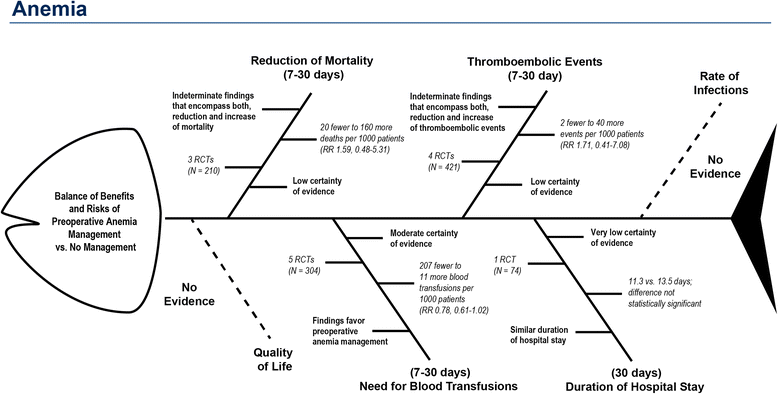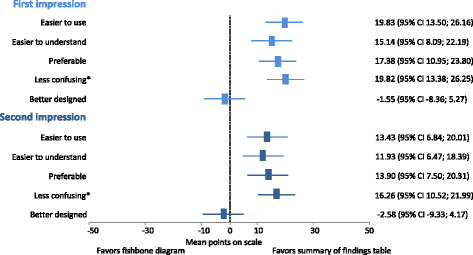User testing of an adaptation of fishbone diagrams to depict results of systematic reviews
- PMID: 29233133
- PMCID: PMC5727698
- DOI: 10.1186/s12874-017-0452-z
User testing of an adaptation of fishbone diagrams to depict results of systematic reviews
Abstract
Background: Summary of findings tables in systematic reviews are highly informative but require epidemiological training to be interpreted correctly. The usage of fishbone diagrams as graphical displays could offer researchers an effective approach to simplify content for readers with limited epidemiological training. In this paper we demonstrate how fishbone diagrams can be applied to systematic reviews and present the results of an initial user testing.
Methods: Findings from two systematic reviews were graphically depicted in the form of the fishbone diagram. To test the utility of fishbone diagrams compared with summary of findings tables, we developed and pilot-tested an online survey using Qualtrics. Respondents were randomized to the fishbone diagram or a summary of findings table presenting the same body of evidence. They answered questions in both open-ended and closed-answer formats; all responses were anonymous. Measures of interest focused on first and second impressions, the ability to find and interpret critical information, as well as user experience with both displays. We asked respondents about the perceived utility of fishbone diagrams compared to summary of findings tables. We analyzed quantitative data by conducting t-tests and comparing descriptive statistics.
Results: Based on real world systematic reviews, we provide two different fishbone diagrams to show how they might be used to display complex information in a clear and succinct manner. User testing on 77 students with basic epidemiological training revealed that participants preferred summary of findings tables over fishbone diagrams. Significantly more participants liked the summary of findings table than the fishbone diagram (71.8% vs. 44.8%; p < .01); significantly more participants found the fishbone diagram confusing (63.2% vs. 35.9%, p < .05) or indicated that it was difficult to find information (65.8% vs. 45%; p < .01). However, more than half of the participants in both groups were unable to find critical information and answer three respective questions correctly (52.6% in the fishbone group; 51.3% in the summary of findings group).
Conclusions: Fishbone diagrams are compact visualizations that, theoretically, may prove useful for summarizing the findings of systematic reviews. Initial user testing, however, did not support the utility of such graphical displays.
Keywords: Evidence summary; Fishbone diagram; Summary of findings; Systematic review; User testing; Visualization.
Conflict of interest statement
Ethics approval and consent to participate
The Danube University Institutional Review Board determined that ethics approval was not required. All students provided verbal informed consent and had sufficient time to consider participation in the study. Written informed consent was deemed unnecessary because no personal risk was involved and written consent is not normally sought for anonymous surveys.
Consent for publication
Not required.
Competing interests
Authors declare that they have no financial or non-financial competing interests.
Publisher’s Note
Springer Nature remains neutral with regard to jurisdictional claims in published maps and institutional affiliations.
Figures




Similar articles
-
I-REFF diagrams: enhancing transparency in systematic review through interactive reference flow diagrams.Syst Rev. 2024 Jan 17;13(1):33. doi: 10.1186/s13643-023-02420-0. Syst Rev. 2024. PMID: 38233900 Free PMC article.
-
An evaluation of harvest plots to display results of meta-analyses in overviews of reviews: a cross-sectional study.BMC Med Res Methodol. 2015 Oct 26;15:91. doi: 10.1186/s12874-015-0084-0. BMC Med Res Methodol. 2015. PMID: 26502717 Free PMC article.
-
Comparison between the standard and a new alternative format of the Summary-of-Findings tables in Cochrane review users: study protocol for a randomized controlled trial.Trials. 2015 Apr 16;16:164. doi: 10.1186/s13063-015-0649-6. Trials. 2015. PMID: 25873338 Free PMC article. Clinical Trial.
-
Venn diagrams in bioinformatics.Brief Bioinform. 2021 Sep 2;22(5):bbab108. doi: 10.1093/bib/bbab108. Brief Bioinform. 2021. PMID: 33839742 Review.
-
Graphical presentation of diagnostic information.BMC Med Res Methodol. 2008 Apr 11;8:20. doi: 10.1186/1471-2288-8-20. BMC Med Res Methodol. 2008. PMID: 18405357 Free PMC article. Review.
Cited by
-
Charting the landscape of graphical displays for meta-analysis and systematic reviews: a comprehensive review, taxonomy, and feature analysis.BMC Med Res Methodol. 2020 Feb 7;20(1):26. doi: 10.1186/s12874-020-0911-9. BMC Med Res Methodol. 2020. PMID: 32028897 Free PMC article. Review.
-
The effectiveness of interventions to disseminate the results of non-commercial randomised clinical trials to healthcare professionals: a systematic review.Implement Sci. 2024 Feb 1;19(1):8. doi: 10.1186/s13012-023-01332-w. Implement Sci. 2024. PMID: 38303034 Free PMC article.
-
Barriers to correct pronoun usage in healthcare settings.BMC Med Educ. 2024 Sep 27;24(1):1056. doi: 10.1186/s12909-024-06032-7. BMC Med Educ. 2024. PMID: 39334283 Free PMC article.
-
An Analysis of the Efficacy of the Health Butler Application and Intelligent Accompaniment Systems in Smart Outpatient Services Based on Patient Feedback.J Multidiscip Healthc. 2024 Dec 4;17:5775-5787. doi: 10.2147/JMDH.S489515. eCollection 2024. J Multidiscip Healthc. 2024. PMID: 39655294 Free PMC article.
References
-
- Guyatt GH, Thorlund K, Oxman AD, Walter SD, Patrick D, Furukawa TA, Johnston BC, Karanicolas P, Akl EA, Vist G. GRADE guidelines: 13. Preparing summary of findings tables and evidence profiles—continuous outcomes. J Clin Epidemiol. 2013;66(2):173–183. doi: 10.1016/j.jclinepi.2012.08.001. - DOI - PubMed
-
- Garcia-Retamero R, Cokely ET. Designing visual aids that promote risk literacy: a systematic review of health research and evidence-based design heuristics. Hum Factors. 2017:0018720817690634. - PubMed
-
- Ishikawa K, DJ L. What is total quality control?: the Japanese way, vol. 215. Englewood Cliffs, NJ: Prentice-Hall; 1985.
MeSH terms
Grants and funding
LinkOut - more resources
Full Text Sources
Other Literature Sources

